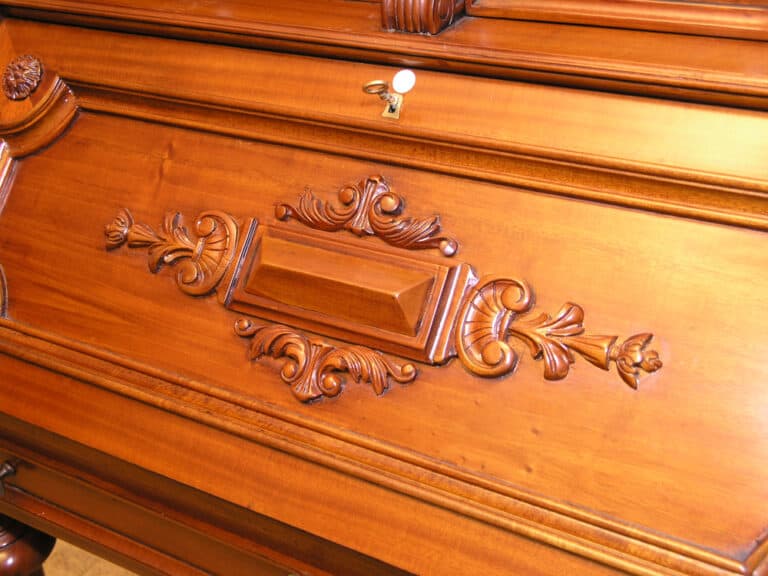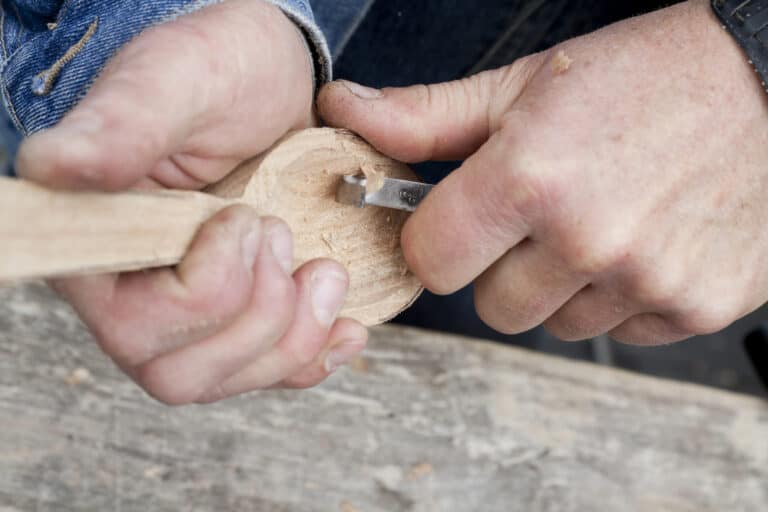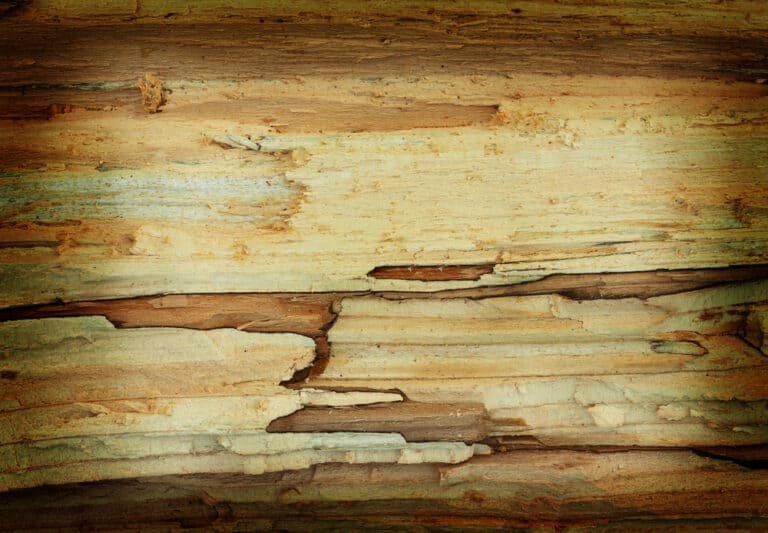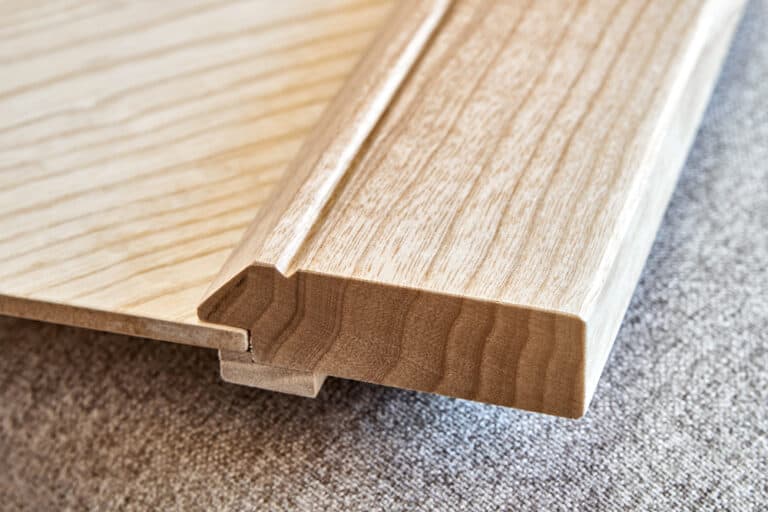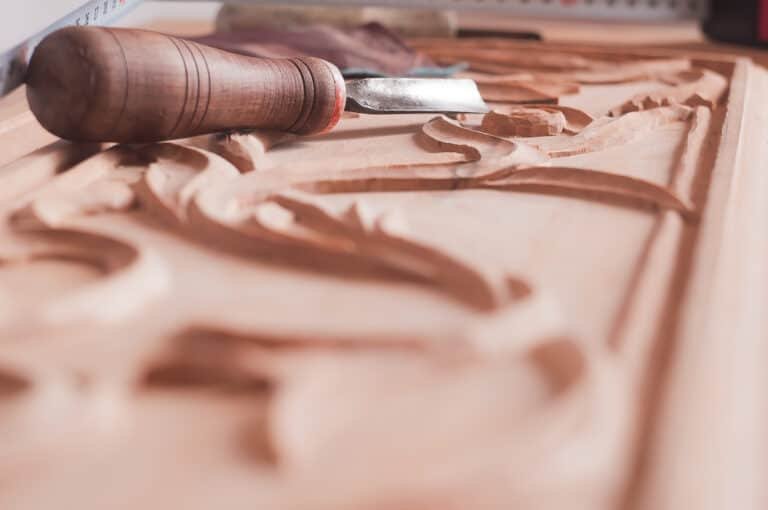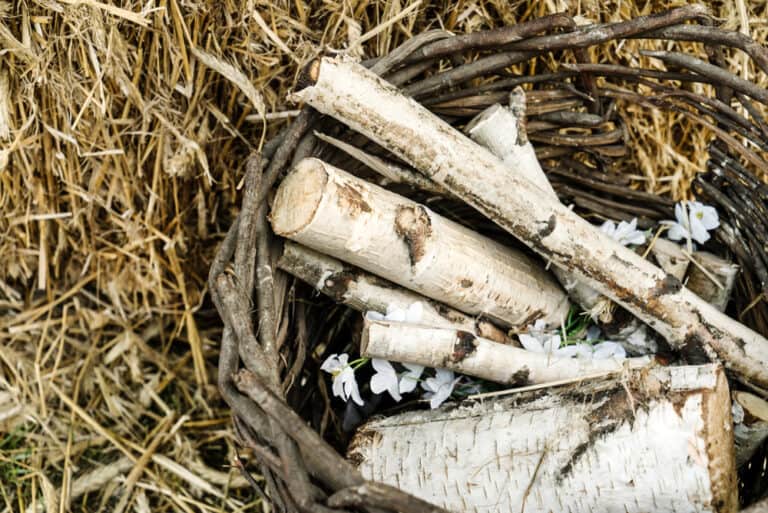Cottonwood is good for beginner woodcarvers because its softness makes it so easy to carve with nothing more than a knife. However, it can splinter easily so experienced wood carvers tend to avoid it.
Cottonwood has certain advantages and disadvantages when used as a material for carving, so let’s take an in-depth look at its properties.

Pros of Carving with Cottonwood:
- Softness: Cottonwood is relatively soft compared to other hardwoods, which makes it easier to carve. This can be especially beneficial for beginners or when intricate details are required.
- Grain: Cottonwood typically has a straight grain, which can reduce the likelihood of the wood splitting unexpectedly during carving.
- Size: Cottonwood trees can grow to be quite large, providing ample material for larger projects.
- Cost: Because cottonwood is not highly valued for fine woodworking, it is often more affordable than other carving woods.
Cons of Carving with Cottonwood:
- Durability: Cottonwood is not as durable as harder woods, which can be a disadvantage for carvings that need to withstand handling or outdoor elements.
- Fuzziness: When carved, cottonwood can sometimes leave a “fuzzy” texture that may require additional sanding and finishing work.
- Moisture Content: Cottonwood tends to retain moisture, which can cause issues with warping or cracking as the wood dries.
- Detail Retention: Due to its softness, cottonwood may not hold fine details as well as harder woods, which can be a limitation for more intricate designs.
Cottonwood Characteristics
- Light yellowish-white color that darkens over time when exposed to air and sunlight.
- The grain of cottonwood varies from straight to wavy depending on how the tree was grown; however, it generally tends to be straight-grained.
- Its texture is fine but slightly coarse compared to other woods like pine or oak.
- Cottonwood is soft and lightweight yet strong enough for most carving projects making it an ideal choice for hobbyists looking for something easy to work with without sacrificing durability.
Tips for Carving Cottonwood
Use Sharp Tools
When working with any type of wood, it’s important to have sharp tools. This is especially true for cottonwood because the grain tends to be quite soft. It is prone to splintering if your tools are not razor-sharp.
Make sure that all of your chisels, gouges, knives, and other cutting implements are in good condition before beginning your project.
Sand Carefully
Cottonwood tends to clog up sandpaper quickly due to its softer nature, so make sure you use a light touch when sanding this material.
Start using coarse grit paper and then move through finer grades until you achieve the desired finish.
You may also want to consider using an electric sander or power carver as these will help speed up the process considerably while still giving excellent results.
Finish With Wax
Once you’ve finished carving your piece of cottonwood, you must protect it from moisture damage by applying a coat of wax or varnish over the surface area.
This will help seal in any oils released during the carving process and give extra protection against dirt and dust buildup, which can lead to staining or discoloration if left untreated.
More Advantages of Carving with Cottonwood
- Cottonwood is a soft, lightweight wood that is easy to carve. It has a low density and is relatively inexpensive compared to other woods.
- The grain of cottonwood can be quite intricate, making it perfect for detailed carvings such as figurines or ornamental pieces. Its light color also adds an interesting contrast when combined with darker woods like walnut or cherry.
- Because of its softness, cottonwood does not require sharp tools for carving and can easily be shaped with hand tools such as chisels and gouges.
- The texture of cottonwood is smooth and even which helps create a polished finish without too much effort.
- Cottonwood takes stain well so you can customize your projects with different colors if desired, giving them more character and depth than plain wood alone would provide.
- When working with this type of wood, there are fewer chances of splintering due to its softer nature, making it safer to work with than harder woods like oak or maple.
- Lastly, because cottonwood is so lightweight, finished projects made from this material will not be too heavy, so they won’t cause any strain on the user while being handled or displayed in homes or galleries.
More Disadvantages of Carving with Cottonwood
- The grain of cottonwood is often irregular, which makes it hard to predict how the wood will react when carved or sanded.
- Cottonwood has a tendency to splinter easily when being carved, which can cause problems with finishing the piece and create extra work in terms of sanding down rough edges or filling in gaps created by splinters.
- Cottonwood also tends to have an uneven texture due to its softness, so achieving a smooth finish on your project may be difficult without additional sanding or smoothing techniques.
- Cottonwood is softer than other types of wood, so it may be less durable when used outdoors or exposed to weather conditions such as rain and snow.
- It is important to consider this before using cottonwood for outdoor projects where durability is essential.
Carving Projects Suited to Cottonwood

- Whittling Projects: Due to its softness, cottonwood is excellent for whittling, which is the art of carving shapes out of raw wood with a knife. It’s a good choice for beginners to practice on.
- Caricatures and Figurines: The soft, workable nature of cottonwood makes it ideal for carving small figures and caricatures where detail is not deeply incised.
- Relief Carving: This wood is suitable for relief carving, where the design is carved into the wood, rather than being in the round. The straight grain helps prevent unexpected splitting.
- Decorative Items: Items like decorative spoons, bowls, or ornaments that are not intended for heavy use can be made from cottonwood. The wood’s softness allows for quick shaping.
- Practice Pieces: For those learning carving techniques, cottonwood is an affordable option for making practice pieces before moving on to harder, more expensive woods.
- Bark Carving: Cottonwood bark, in particular, is popular for carving rustic scenes, whimsical houses, and faces. Its thick bark can be removed in large pieces and is often used for these types of projects.
- Signs and Plaques: For indoor signs and plaques, cottonwood can be a good choice, especially if the sign is painted after carving.
- Wooden Toys: Softwoods like cottonwood are often used for toys because they’re easier to shape and sand smooth to ensure there are no sharp edges or splinters.
- Theatrical Props: For props that need to be lightweight and are not subject to close scrutiny, cottonwood is a practical choice.
- Mock-ups and Prototypes: When creating a prototype for a carving project, cottonwood is an excellent material due to its low cost and ease of carving.
Cottonwood Finishing Techniques
To address the cons of cottonwood, such as its tendency to fuzz up when carved, its poor durability, and its propensity to retain moisture, here are some finishing techniques that can help:
Sanding
- Fine Grit Sandpaper: After carving, use progressively finer grit sandpaper to smooth out the surface. This can help eliminate the fuzziness that cottonwood is prone to.
- Wet Sanding: This technique can be used to reduce dust and also to get a smoother finish on the wood.
Sealing
- Sand Sealer: Apply a sanding sealer before the final finishing coats. This will help to fill the grain and provide a smoother base for the final finish.
- Wood Conditioner: Especially for cottonwood, which can absorb stains unevenly, a pre-stain wood conditioner can help ensure a more uniform finish.
Staining
- Gel Stains: These are thicker than liquid stains and tend to sit on the wood’s surface, which can be beneficial for cottonwood to provide a more even color without over-absorption.
Painting
- Primer: Use a high-quality primer to prepare the wood for painting. This can help to cover any imperfections and prevent the paint from soaking into the wood.
- Acrylic Paints: These are a good choice for cottonwood as they can provide a durable finish and come in a variety of colors.
Varnishing
- Polyurethane: A coat of polyurethane can protect the wood from moisture and wear. It’s available in various sheens and can be applied with a brush or as a spray.
- Epoxy Resin: For a high-gloss, protective finish, epoxy resin can be applied. This is particularly useful for items that will be handled frequently or are decorative.
Waxing
- Paste Wax: After the final finish, applying a coat of paste wax can give the wood a soft sheen and provide an additional layer of protection.
Oiling
- Danish or Linseed Oil: These oils can penetrate the wood and harden, providing a level of protection and bringing out the natural beauty of the wood grain.
Lacquer
- Spray Lacquer: This finish dries quickly and can be built up in thin layers to provide a durable surface that is less likely to be affected by the wood’s tendency to retain moisture.
Moisture Control
- Dehumidifier: If the wood is still green or contains moisture, using a dehumidifier in the workspace can help reduce the moisture content before and after carving.
